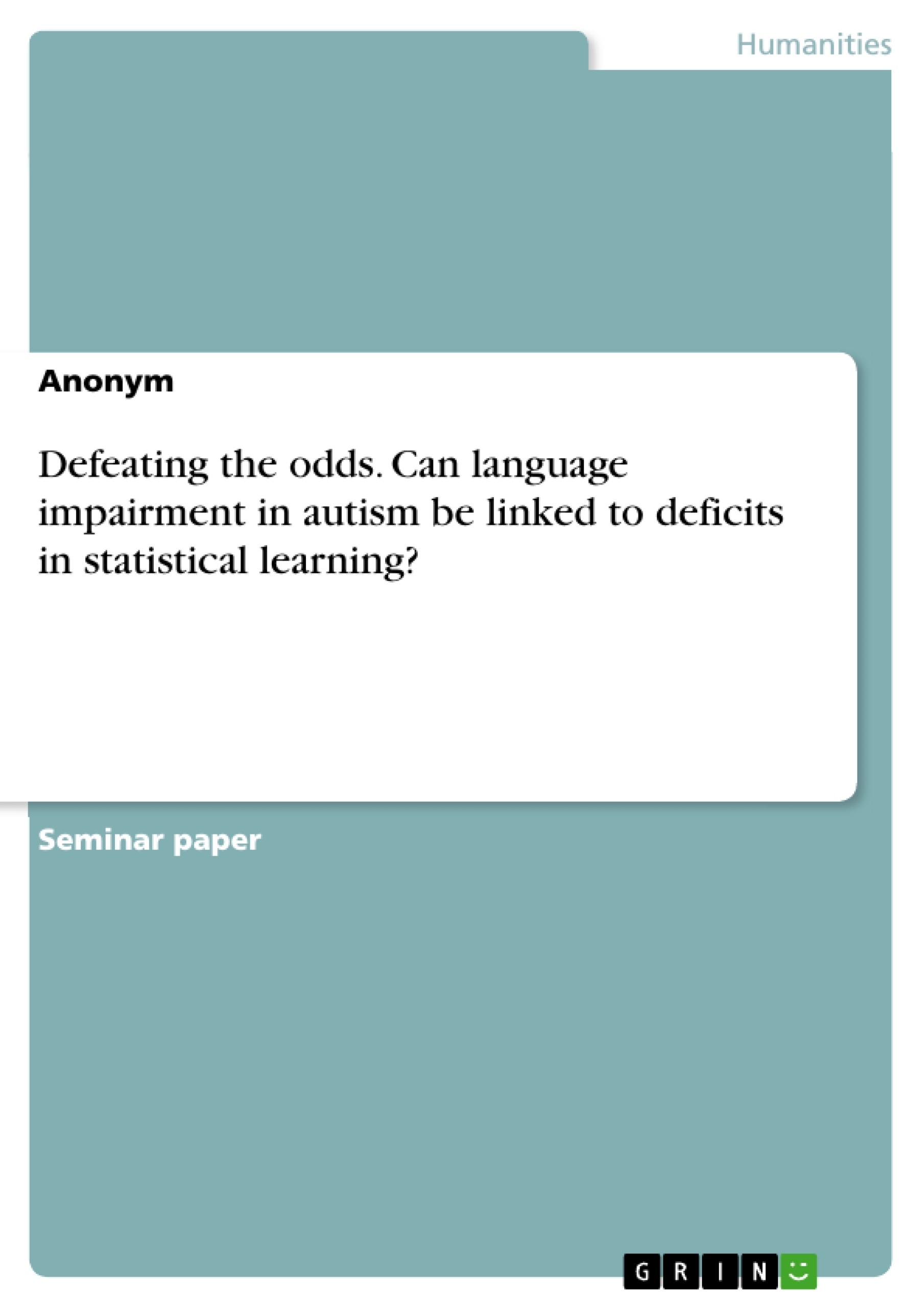Can language impairments in autism be linked to deficits in statistical learning? Answering this question is of interest for multiple reasons: It may shed more light on the general mechanisms of language acquisition and development and illustrate how statistical learning contributes to the ability to communicate. Furthermore, understanding the underlying mechanisms of linguistic impairments associated with autism and other disorders is imperative in order to develop effective therapeutic methods and interventions to help those affected, preferably at an early stage in life.
Georg-August-Universität Göttingen
Wissenschaftliche Kompetenzen für die Psychologie
Language impairment is a prevalent characteristic of autism, resulting in what author and autistic savant Daniel Tammet describes as a “disconnect between man and language” (Tammet, 2017, p. 3). Apart from abnormalities in verbal and non-verbal communication, autism spectrum disorder is characterized by difficulties in social interaction along with repetitive and restrictive behavior (World Health Organization, 2004). Deficits and typical features related to language and speech can include delayed and overall slower language development, diminished use of language in social contexts, limited vocal output as well as atypical vocal quality and accentuation (Tager-Flusberg, Paul, & Lord, 2005). The language impairments observed in autism vary across ages, developmental levels and severity of the disorder, contributing to its heterogeneity (Mody & Belliveau, 2013).
Of the many factors contributing to language acquisition, statistical learning has been implicated as playing an important role (Romberg & Saffran, 2010; Saffran, 2003), possibly making this mechanism relevant for language development in autism. Statistical learning, which can be defined as “the discovery of patterns in the input” (Romberg & Saffran, 2010, p. 906), becomes significant for instance when determining word boundaries (Pelucchi, Hay, & Saffran, 2009; Saffran, Aslin, & Newport, 1996) or figuring out the rules of grammar (Marcus, Vijayan, Bandi, & Vishton, 1999). While there has been some research studying implicit learning in autism (Barnes et al., 2008; Motofsky, Goldberg, Landa, & Denckla, 2000; Roser, Aslin, McKenzie, Zahra, & Fiser, 2015) and the general relationship between statistical learning and language acquisition (Marcus et al., 1999; Pelucchi et al., 2009; Saffran et al., 1996), only a few studies have investigated statistical learning and language abilities in children with autism in direct comparison with typically developing (TD) individuals. Some studies have factored in neural activity correlated with implicit learning, suggesting atypical language-association cortex asymmetry (De Fossé et al., 2004; Herbert et al., 2002). Currently there is no conclusive consensus regarding the underlying mechanisms of language deficits in autism, with many different accounts aiming to decipher the linguistic abnormalities associated with the disorder (Charman, 2003; Gernsbacher, Sauer, Geye, Schweigert, & Hill Goldsmith, 2008; Henderson, Powell, Gareth Gaskell, & Norbury, 2014). This unresolved aspect points to more specific research into autism and language development being needed and – considering previous findings regarding the role of statistical learning – leads to the central question: Can language impairments in autism be linked to deficits in statistical learning? Answering this question is of interest for multiple reasons: It may shed more light on the general mechanisms of language acquisition and development and illustrate how statistical learning contributes to the ability to communicate. Furthermore, understanding the underlying mechanisms of linguistic impairments associated with autism and other disorders is imperative in order to develop effective therapeutic methods and interventions to help those affected, preferably at an early stage in life.
A wide range of procedures has been used to study statistical learning in various populations. For the purpose of comparing research and investigating the relationship between statistical learning and communication, the focus will be on word segmentation tasks, which could provide an essential clue regarding the mechanisms of linguistic challenges in autism. Moreover, looking at the neural activity during those tasks may offer a more in depth understanding of the systems at play. With word segmentation tasks in mind, investigating the relationship between statistical learning and language deficits in autism yields the following questions: Is statistical learning intact in individuals with autism? How do individuals with autism perform on word segmentation tasks compared to TD peers? What does neural activity during statistical learning tasks look like?
One account supporting the possible link between statistical learning and language impairments is the procedural deficit hypothesis (PDH) proposed by Ullmann and Pierpont (2005). The PDH posits that impaired procedural learning, precipitated by neural deficits, can account for the language abnormalities seen in specific language impairment (SLI).
[...]
- Citar trabajo
- Anónimo,, 2019, Defeating the odds. Can language impairment in autism be linked to deficits in statistical learning?, Múnich, GRIN Verlag, https://www.grin.com/document/1244473
-

-

-

-
¡Carge sus propios textos! Gane dinero y un iPhone X. -

-
¡Carge sus propios textos! Gane dinero y un iPhone X. -

-
¡Carge sus propios textos! Gane dinero y un iPhone X. -

-
¡Carge sus propios textos! Gane dinero y un iPhone X. -

-
¡Carge sus propios textos! Gane dinero y un iPhone X.

